Project 5DER: Analyzing Contemporary Employment Relations Issues
VerifiedAdded on 2023/02/02
|26
|8975
|93
Project
AI Summary
This project, titled Project 5DER, analyzes contemporary developments in employment relations. It begins by exploring the indeterminate nature of employee relations and contrasts unitarist and pluralist approaches, examining factors affecting employment relationships. The project then delves into the features of employment contracts and sources of UK and EU employment law. It further examines statutory trade union recognition, employee involvement, and different forms of employee representation, comparing union and non-union models and assessing the link between employee voice and organizational performance. The project also covers conflict, including misbehavior, industrial action, and contemporary trends in these areas. Finally, it addresses managerial skills for handling grievances and disputes, including third-party conciliation, mediation, and arbitration. The project demonstrates an understanding of key concepts within employment relations, offering insights into various aspects of workplace dynamics and legal frameworks.
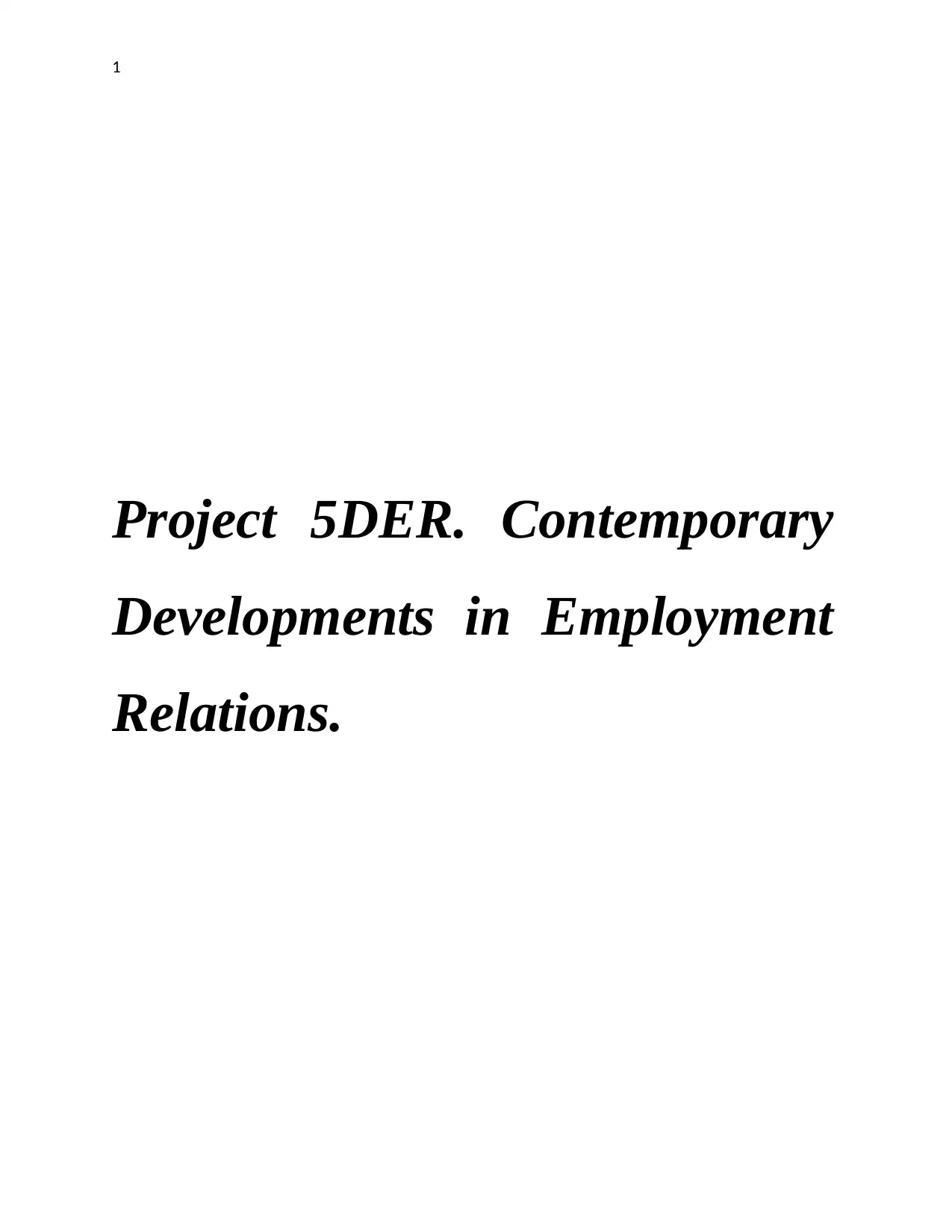
1
Project 5DER. Contemporary
Developments in Employment
Relations.
Project 5DER. Contemporary
Developments in Employment
Relations.
Paraphrase This Document
Need a fresh take? Get an instant paraphrase of this document with our AI Paraphraser

2
Table of Contents
Question 1:.............................................................................................................................................3
1.1 Indeterminate nature of Employee Relations....................................................................................3
1.2 Compare and contrast of unitarist and pluralist approach.................................................................3
1.3 Factors affecting employment relations............................................................................................4
Question 2:..................................................................................................................................................6
2.1 Features of the contract of employment............................................................................................6
2.2 Sources of UK and EU employment relations..................................................................................7
2.3 Main Developments in individual and employment law...................................................................8
Question 3:..................................................................................................................................................8
2.4 Purpose and scope of statutory trade union recognition....................................................................8
Question 4:................................................................................................................................................10
3.1 Employee involvement, participation and partnership....................................................................10
3.2 Compare and contrast union and non-union forms of employee representation..............................10
3.3 Assess link between employee voice and organization performance- Employee voice and
participation..........................................................................................................................................11
Question 5:................................................................................................................................................13
4.1 Difference in misbehavior, conflict and official and unofficial industrial action. ..........................13
4.2 Contemporary trends in types of conflict and industrial sanctions..................................................14
Question 6:................................................................................................................................................15
4.3 Managerial skills for effective grievance and dispute handling......................................................15
4.4 Third party conciliation, mediation and arbitration.........................................................................16
Table of Contents
Question 1:.............................................................................................................................................3
1.1 Indeterminate nature of Employee Relations....................................................................................3
1.2 Compare and contrast of unitarist and pluralist approach.................................................................3
1.3 Factors affecting employment relations............................................................................................4
Question 2:..................................................................................................................................................6
2.1 Features of the contract of employment............................................................................................6
2.2 Sources of UK and EU employment relations..................................................................................7
2.3 Main Developments in individual and employment law...................................................................8
Question 3:..................................................................................................................................................8
2.4 Purpose and scope of statutory trade union recognition....................................................................8
Question 4:................................................................................................................................................10
3.1 Employee involvement, participation and partnership....................................................................10
3.2 Compare and contrast union and non-union forms of employee representation..............................10
3.3 Assess link between employee voice and organization performance- Employee voice and
participation..........................................................................................................................................11
Question 5:................................................................................................................................................13
4.1 Difference in misbehavior, conflict and official and unofficial industrial action. ..........................13
4.2 Contemporary trends in types of conflict and industrial sanctions..................................................14
Question 6:................................................................................................................................................15
4.3 Managerial skills for effective grievance and dispute handling......................................................15
4.4 Third party conciliation, mediation and arbitration.........................................................................16
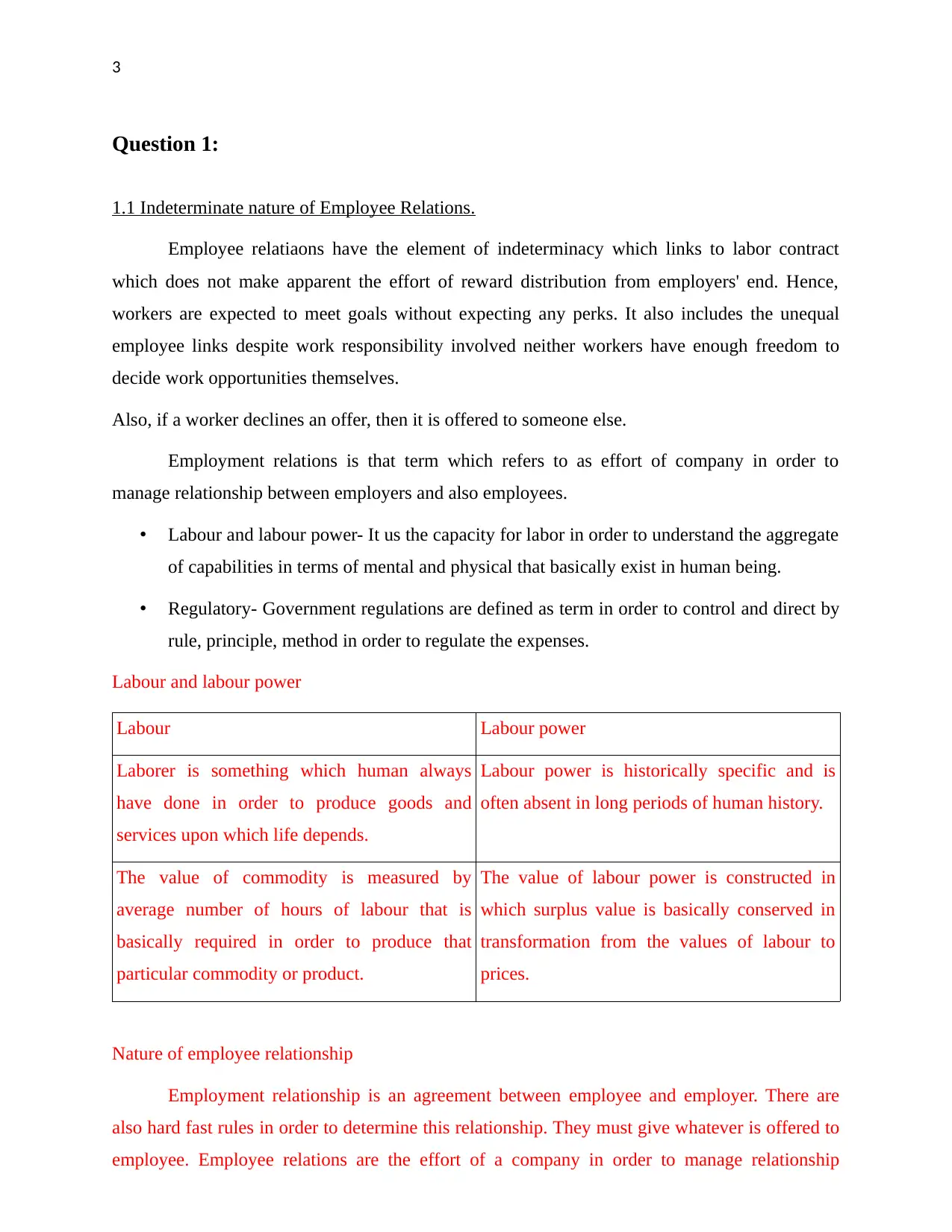
3
Question 1:
1.1 Indeterminate nature of Employee Relations.
Employee relatiaons have the element of indeterminacy which links to labor contract
which does not make apparent the effort of reward distribution from employers' end. Hence,
workers are expected to meet goals without expecting any perks. It also includes the unequal
employee links despite work responsibility involved neither workers have enough freedom to
decide work opportunities themselves.
Also, if a worker declines an offer, then it is offered to someone else.
Employment relations is that term which refers to as effort of company in order to
manage relationship between employers and also employees.
• Labour and labour power- It us the capacity for labor in order to understand the aggregate
of capabilities in terms of mental and physical that basically exist in human being.
• Regulatory- Government regulations are defined as term in order to control and direct by
rule, principle, method in order to regulate the expenses.
Labour and labour power
Labour Labour power
Laborer is something which human always
have done in order to produce goods and
services upon which life depends.
Labour power is historically specific and is
often absent in long periods of human history.
The value of commodity is measured by
average number of hours of labour that is
basically required in order to produce that
particular commodity or product.
The value of labour power is constructed in
which surplus value is basically conserved in
transformation from the values of labour to
prices.
Nature of employee relationship
Employment relationship is an agreement between employee and employer. There are
also hard fast rules in order to determine this relationship. They must give whatever is offered to
employee. Employee relations are the effort of a company in order to manage relationship
Question 1:
1.1 Indeterminate nature of Employee Relations.
Employee relatiaons have the element of indeterminacy which links to labor contract
which does not make apparent the effort of reward distribution from employers' end. Hence,
workers are expected to meet goals without expecting any perks. It also includes the unequal
employee links despite work responsibility involved neither workers have enough freedom to
decide work opportunities themselves.
Also, if a worker declines an offer, then it is offered to someone else.
Employment relations is that term which refers to as effort of company in order to
manage relationship between employers and also employees.
• Labour and labour power- It us the capacity for labor in order to understand the aggregate
of capabilities in terms of mental and physical that basically exist in human being.
• Regulatory- Government regulations are defined as term in order to control and direct by
rule, principle, method in order to regulate the expenses.
Labour and labour power
Labour Labour power
Laborer is something which human always
have done in order to produce goods and
services upon which life depends.
Labour power is historically specific and is
often absent in long periods of human history.
The value of commodity is measured by
average number of hours of labour that is
basically required in order to produce that
particular commodity or product.
The value of labour power is constructed in
which surplus value is basically conserved in
transformation from the values of labour to
prices.
Nature of employee relationship
Employment relationship is an agreement between employee and employer. There are
also hard fast rules in order to determine this relationship. They must give whatever is offered to
employee. Employee relations are the effort of a company in order to manage relationship
⊘ This is a preview!⊘
Do you want full access?
Subscribe today to unlock all pages.

Trusted by 1+ million students worldwide

4
between the superior and subordinates of particular organization. Thus, if there is good
relationship than it will lead them in providing fair and consistent treatment to everyone so that it
will assist them in committing to their task or role and also be loyal to their workplace.
Labour and Labour Power, definition: organization strategic recruitment process to attract
human labour to the organization job opportunities, human labour with the right skills, the right
knowledge, eligible, and for the right role which reverses later into a high turnover as result of
hiring the right human labour.
Furthermore, human labour is a worker(s) who bring his/her services/skills to an organization for
sell and he/she will sell their services/skills to the organization when a contract of employment
have been agreed and signed between employer and employee and the capitalist employer owns
the means of production (ex: factory, office, equipment, raw materials, etc) with the help of
skilled human labour which help the organization to increase their turnover. However, if the
organization hire unfit human labour, the new human labour will more than likely cause a
discrepancy in organization high turnover, it can also result in earlier resignation, damage some
of the organization facilities or delete important information, especially if the organization hired
unfit human labour and failed to provide an induction and training the new human labour and
monitor their activities in the organization. It is important to monitor the human labour as it helps
the organization to establish training needs in order to not only keep the employees motivated but
also help the employees to develop within the organization which will result in improving the
organization productivity.
In the same time human labour has the power to hold the organization from going forward
to improve or continue its production by taking legal strikes, take legal actions against the
organization as court proceedings for: breaching the contract, employee(s) rights, employee(s)
accident as result of organization not following health and safety procedures, etc,.
1.2 Compare and contrast of unitarist and pluralist approach.
Unitarist definition: an individual or a group of individuals who work in an organization
with the organization shareholders, managers, leaders, HR towards achieving common goals, all
members (mangers and staff) share the same interest (Alan Fox, 1966).
Pluralist definition: a frame of reference focuses more on incriminating and collective
bargaining agreements identifying different interests within sub-groups can cause conflict, in
most cases between the management and trade union (Alan Fox, 1966). Pluralism acknowledge
between the superior and subordinates of particular organization. Thus, if there is good
relationship than it will lead them in providing fair and consistent treatment to everyone so that it
will assist them in committing to their task or role and also be loyal to their workplace.
Labour and Labour Power, definition: organization strategic recruitment process to attract
human labour to the organization job opportunities, human labour with the right skills, the right
knowledge, eligible, and for the right role which reverses later into a high turnover as result of
hiring the right human labour.
Furthermore, human labour is a worker(s) who bring his/her services/skills to an organization for
sell and he/she will sell their services/skills to the organization when a contract of employment
have been agreed and signed between employer and employee and the capitalist employer owns
the means of production (ex: factory, office, equipment, raw materials, etc) with the help of
skilled human labour which help the organization to increase their turnover. However, if the
organization hire unfit human labour, the new human labour will more than likely cause a
discrepancy in organization high turnover, it can also result in earlier resignation, damage some
of the organization facilities or delete important information, especially if the organization hired
unfit human labour and failed to provide an induction and training the new human labour and
monitor their activities in the organization. It is important to monitor the human labour as it helps
the organization to establish training needs in order to not only keep the employees motivated but
also help the employees to develop within the organization which will result in improving the
organization productivity.
In the same time human labour has the power to hold the organization from going forward
to improve or continue its production by taking legal strikes, take legal actions against the
organization as court proceedings for: breaching the contract, employee(s) rights, employee(s)
accident as result of organization not following health and safety procedures, etc,.
1.2 Compare and contrast of unitarist and pluralist approach.
Unitarist definition: an individual or a group of individuals who work in an organization
with the organization shareholders, managers, leaders, HR towards achieving common goals, all
members (mangers and staff) share the same interest (Alan Fox, 1966).
Pluralist definition: a frame of reference focuses more on incriminating and collective
bargaining agreements identifying different interests within sub-groups can cause conflict, in
most cases between the management and trade union (Alan Fox, 1966). Pluralism acknowledge
Paraphrase This Document
Need a fresh take? Get an instant paraphrase of this document with our AI Paraphraser
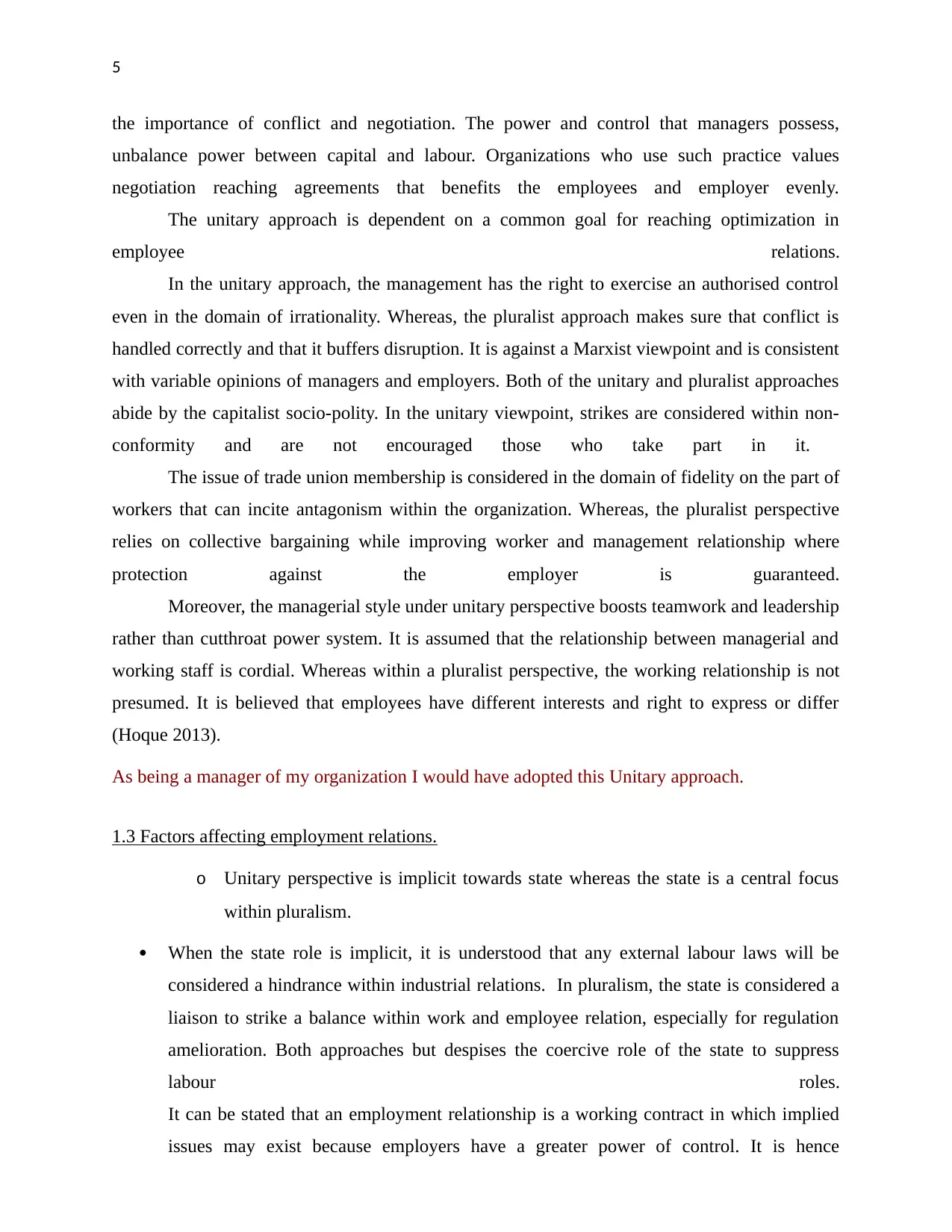
5
the importance of conflict and negotiation. The power and control that managers possess,
unbalance power between capital and labour. Organizations who use such practice values
negotiation reaching agreements that benefits the employees and employer evenly.
The unitary approach is dependent on a common goal for reaching optimization in
employee relations.
In the unitary approach, the management has the right to exercise an authorised control
even in the domain of irrationality. Whereas, the pluralist approach makes sure that conflict is
handled correctly and that it buffers disruption. It is against a Marxist viewpoint and is consistent
with variable opinions of managers and employers. Both of the unitary and pluralist approaches
abide by the capitalist socio-polity. In the unitary viewpoint, strikes are considered within non-
conformity and are not encouraged those who take part in it.
The issue of trade union membership is considered in the domain of fidelity on the part of
workers that can incite antagonism within the organization. Whereas, the pluralist perspective
relies on collective bargaining while improving worker and management relationship where
protection against the employer is guaranteed.
Moreover, the managerial style under unitary perspective boosts teamwork and leadership
rather than cutthroat power system. It is assumed that the relationship between managerial and
working staff is cordial. Whereas within a pluralist perspective, the working relationship is not
presumed. It is believed that employees have different interests and right to express or differ
(Hoque 2013).
As being a manager of my organization I would have adopted this Unitary approach.
1.3 Factors affecting employment relations.
o Unitary perspective is implicit towards state whereas the state is a central focus
within pluralism.
When the state role is implicit, it is understood that any external labour laws will be
considered a hindrance within industrial relations. In pluralism, the state is considered a
liaison to strike a balance within work and employee relation, especially for regulation
amelioration. Both approaches but despises the coercive role of the state to suppress
labour roles.
It can be stated that an employment relationship is a working contract in which implied
issues may exist because employers have a greater power of control. It is hence
the importance of conflict and negotiation. The power and control that managers possess,
unbalance power between capital and labour. Organizations who use such practice values
negotiation reaching agreements that benefits the employees and employer evenly.
The unitary approach is dependent on a common goal for reaching optimization in
employee relations.
In the unitary approach, the management has the right to exercise an authorised control
even in the domain of irrationality. Whereas, the pluralist approach makes sure that conflict is
handled correctly and that it buffers disruption. It is against a Marxist viewpoint and is consistent
with variable opinions of managers and employers. Both of the unitary and pluralist approaches
abide by the capitalist socio-polity. In the unitary viewpoint, strikes are considered within non-
conformity and are not encouraged those who take part in it.
The issue of trade union membership is considered in the domain of fidelity on the part of
workers that can incite antagonism within the organization. Whereas, the pluralist perspective
relies on collective bargaining while improving worker and management relationship where
protection against the employer is guaranteed.
Moreover, the managerial style under unitary perspective boosts teamwork and leadership
rather than cutthroat power system. It is assumed that the relationship between managerial and
working staff is cordial. Whereas within a pluralist perspective, the working relationship is not
presumed. It is believed that employees have different interests and right to express or differ
(Hoque 2013).
As being a manager of my organization I would have adopted this Unitary approach.
1.3 Factors affecting employment relations.
o Unitary perspective is implicit towards state whereas the state is a central focus
within pluralism.
When the state role is implicit, it is understood that any external labour laws will be
considered a hindrance within industrial relations. In pluralism, the state is considered a
liaison to strike a balance within work and employee relation, especially for regulation
amelioration. Both approaches but despises the coercive role of the state to suppress
labour roles.
It can be stated that an employment relationship is a working contract in which implied
issues may exist because employers have a greater power of control. It is hence
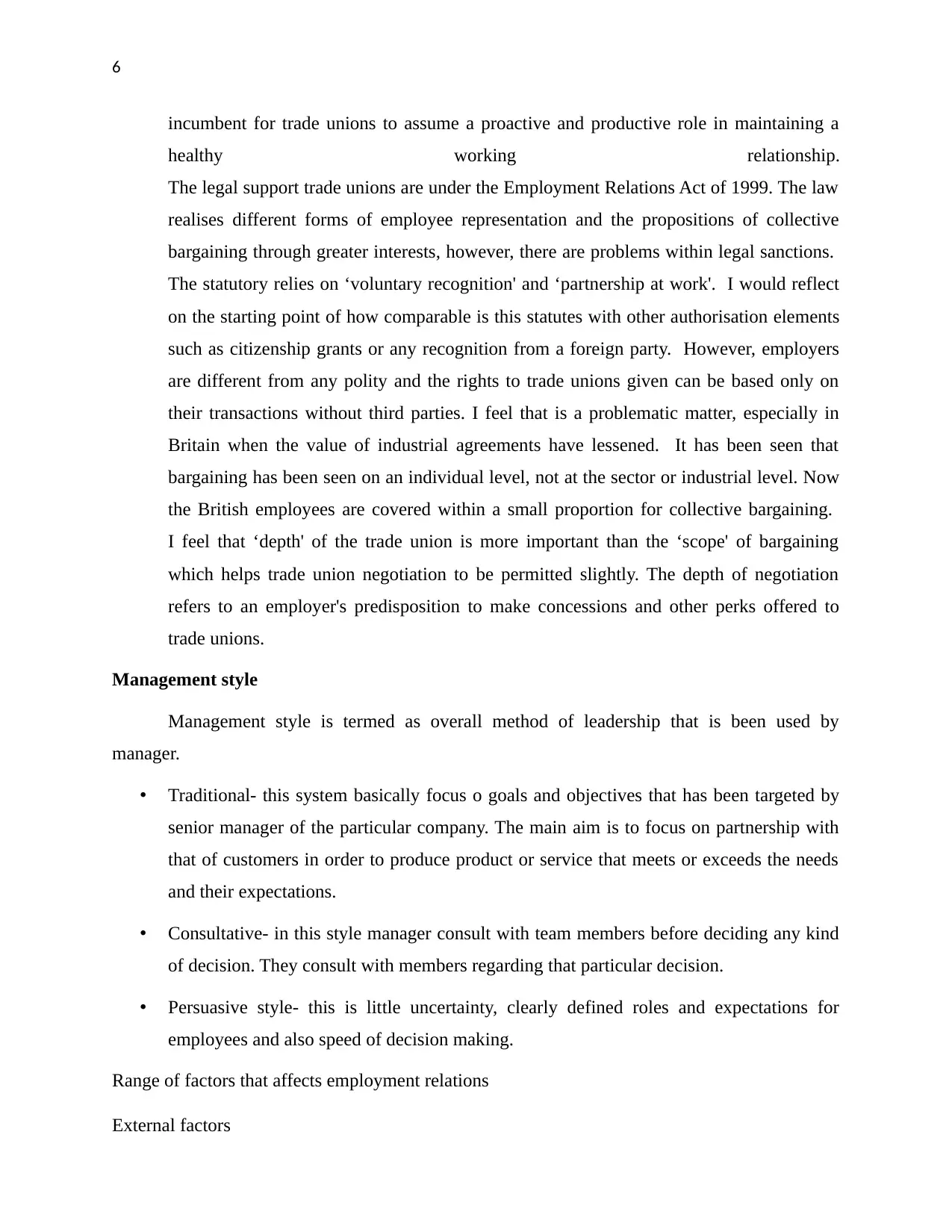
6
incumbent for trade unions to assume a proactive and productive role in maintaining a
healthy working relationship.
The legal support trade unions are under the Employment Relations Act of 1999. The law
realises different forms of employee representation and the propositions of collective
bargaining through greater interests, however, there are problems within legal sanctions.
The statutory relies on ‘voluntary recognition' and ‘partnership at work'. I would reflect
on the starting point of how comparable is this statutes with other authorisation elements
such as citizenship grants or any recognition from a foreign party. However, employers
are different from any polity and the rights to trade unions given can be based only on
their transactions without third parties. I feel that is a problematic matter, especially in
Britain when the value of industrial agreements have lessened. It has been seen that
bargaining has been seen on an individual level, not at the sector or industrial level. Now
the British employees are covered within a small proportion for collective bargaining.
I feel that ‘depth' of the trade union is more important than the ‘scope' of bargaining
which helps trade union negotiation to be permitted slightly. The depth of negotiation
refers to an employer's predisposition to make concessions and other perks offered to
trade unions.
Management style
Management style is termed as overall method of leadership that is been used by
manager.
• Traditional- this system basically focus o goals and objectives that has been targeted by
senior manager of the particular company. The main aim is to focus on partnership with
that of customers in order to produce product or service that meets or exceeds the needs
and their expectations.
• Consultative- in this style manager consult with team members before deciding any kind
of decision. They consult with members regarding that particular decision.
• Persuasive style- this is little uncertainty, clearly defined roles and expectations for
employees and also speed of decision making.
Range of factors that affects employment relations
External factors
incumbent for trade unions to assume a proactive and productive role in maintaining a
healthy working relationship.
The legal support trade unions are under the Employment Relations Act of 1999. The law
realises different forms of employee representation and the propositions of collective
bargaining through greater interests, however, there are problems within legal sanctions.
The statutory relies on ‘voluntary recognition' and ‘partnership at work'. I would reflect
on the starting point of how comparable is this statutes with other authorisation elements
such as citizenship grants or any recognition from a foreign party. However, employers
are different from any polity and the rights to trade unions given can be based only on
their transactions without third parties. I feel that is a problematic matter, especially in
Britain when the value of industrial agreements have lessened. It has been seen that
bargaining has been seen on an individual level, not at the sector or industrial level. Now
the British employees are covered within a small proportion for collective bargaining.
I feel that ‘depth' of the trade union is more important than the ‘scope' of bargaining
which helps trade union negotiation to be permitted slightly. The depth of negotiation
refers to an employer's predisposition to make concessions and other perks offered to
trade unions.
Management style
Management style is termed as overall method of leadership that is been used by
manager.
• Traditional- this system basically focus o goals and objectives that has been targeted by
senior manager of the particular company. The main aim is to focus on partnership with
that of customers in order to produce product or service that meets or exceeds the needs
and their expectations.
• Consultative- in this style manager consult with team members before deciding any kind
of decision. They consult with members regarding that particular decision.
• Persuasive style- this is little uncertainty, clearly defined roles and expectations for
employees and also speed of decision making.
Range of factors that affects employment relations
External factors
⊘ This is a preview!⊘
Do you want full access?
Subscribe today to unlock all pages.

Trusted by 1+ million students worldwide
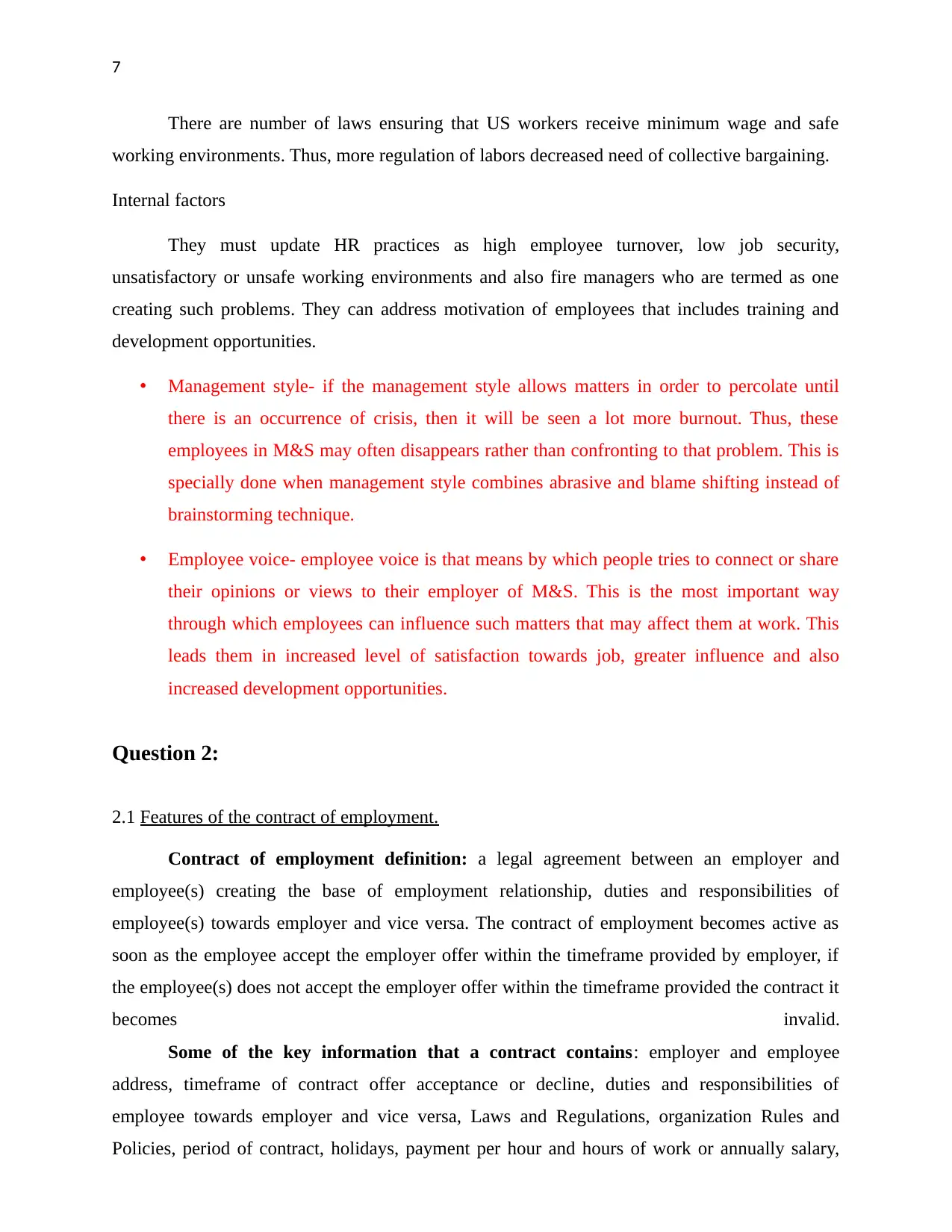
7
There are number of laws ensuring that US workers receive minimum wage and safe
working environments. Thus, more regulation of labors decreased need of collective bargaining.
Internal factors
They must update HR practices as high employee turnover, low job security,
unsatisfactory or unsafe working environments and also fire managers who are termed as one
creating such problems. They can address motivation of employees that includes training and
development opportunities.
• Management style- if the management style allows matters in order to percolate until
there is an occurrence of crisis, then it will be seen a lot more burnout. Thus, these
employees in M&S may often disappears rather than confronting to that problem. This is
specially done when management style combines abrasive and blame shifting instead of
brainstorming technique.
• Employee voice- employee voice is that means by which people tries to connect or share
their opinions or views to their employer of M&S. This is the most important way
through which employees can influence such matters that may affect them at work. This
leads them in increased level of satisfaction towards job, greater influence and also
increased development opportunities.
Question 2:
2.1 Features of the contract of employment.
Contract of employment definition: a legal agreement between an employer and
employee(s) creating the base of employment relationship, duties and responsibilities of
employee(s) towards employer and vice versa. The contract of employment becomes active as
soon as the employee accept the employer offer within the timeframe provided by employer, if
the employee(s) does not accept the employer offer within the timeframe provided the contract it
becomes invalid.
Some of the key information that a contract contains: employer and employee
address, timeframe of contract offer acceptance or decline, duties and responsibilities of
employee towards employer and vice versa, Laws and Regulations, organization Rules and
Policies, period of contract, holidays, payment per hour and hours of work or annually salary,
There are number of laws ensuring that US workers receive minimum wage and safe
working environments. Thus, more regulation of labors decreased need of collective bargaining.
Internal factors
They must update HR practices as high employee turnover, low job security,
unsatisfactory or unsafe working environments and also fire managers who are termed as one
creating such problems. They can address motivation of employees that includes training and
development opportunities.
• Management style- if the management style allows matters in order to percolate until
there is an occurrence of crisis, then it will be seen a lot more burnout. Thus, these
employees in M&S may often disappears rather than confronting to that problem. This is
specially done when management style combines abrasive and blame shifting instead of
brainstorming technique.
• Employee voice- employee voice is that means by which people tries to connect or share
their opinions or views to their employer of M&S. This is the most important way
through which employees can influence such matters that may affect them at work. This
leads them in increased level of satisfaction towards job, greater influence and also
increased development opportunities.
Question 2:
2.1 Features of the contract of employment.
Contract of employment definition: a legal agreement between an employer and
employee(s) creating the base of employment relationship, duties and responsibilities of
employee(s) towards employer and vice versa. The contract of employment becomes active as
soon as the employee accept the employer offer within the timeframe provided by employer, if
the employee(s) does not accept the employer offer within the timeframe provided the contract it
becomes invalid.
Some of the key information that a contract contains: employer and employee
address, timeframe of contract offer acceptance or decline, duties and responsibilities of
employee towards employer and vice versa, Laws and Regulations, organization Rules and
Policies, period of contract, holidays, payment per hour and hours of work or annually salary,
Paraphrase This Document
Need a fresh take? Get an instant paraphrase of this document with our AI Paraphraser

8
pension, changes to contract, terms and conditions, breaching the contract, organization rights,
using information, etc. (ACAS, 2018).
- A contract of employment helps employer and employee to understand each other, and it is
good to spell out each feature in detail to avoid any conflicts in future. It is important first to
define the position to an employee in which he or she has a clear understanding of job
descriptive duties in a concise and simple language. However, this is what employee does expect
before applying to the job. Then the length of the agreement is another essential key feature
along with stipulation of conditions that are necessary to know in case of reduction or
termination in future. This feature also includes a probationary period (Bolan et al., 2017).
- An employment contract also carries review on performance. It is important for the contract to
enlist the specific aspects that are required in gauging performance so that employee can also
expect a bonus or a fringe benefit. For example, a sale based position should let know that what
target of sales achieves can reap a bonus for the potential employee.
- Moreover, there is a feature of compensation that what let know payment modes on the basis of
monthly, hourly, weekly or even commission based remuneration options. It is essential for the
company to list the incentive program along with objectives clearly. If this is present, then the
employer must make sure that handling of expenses account is also mentioned. Especially,
overtime schedules should also be taken into account.
- Along with this, the benefits' package needs to be described. The contract must include health,
dental or vision packages along with premium detail that is levied upon the employee due to
licenses or formal memberships. Often contractual agreements skip the part of vacations, stock
options and other rewarding programs that employee may take advantage. Other contractual
elements involve covenants such as non-disclosure of a company's confidential information, any
non-solicitation time spans and laws (Nyberg & Anthony, 2014).
- Moreover, although not being an attractive part of the contract but it is essential to mention
termination policy so either party can hedge against any unpleasant effect. It is important to
explain that what would occur if an employee is gone either with or without reason.
Contents of a contract of employment
• Holiday entitlement- this is the most important content of contract of employment. As all
workers have from first day of employment the right to pay till 5 to 6 weeks paid holiday
per year.
pension, changes to contract, terms and conditions, breaching the contract, organization rights,
using information, etc. (ACAS, 2018).
- A contract of employment helps employer and employee to understand each other, and it is
good to spell out each feature in detail to avoid any conflicts in future. It is important first to
define the position to an employee in which he or she has a clear understanding of job
descriptive duties in a concise and simple language. However, this is what employee does expect
before applying to the job. Then the length of the agreement is another essential key feature
along with stipulation of conditions that are necessary to know in case of reduction or
termination in future. This feature also includes a probationary period (Bolan et al., 2017).
- An employment contract also carries review on performance. It is important for the contract to
enlist the specific aspects that are required in gauging performance so that employee can also
expect a bonus or a fringe benefit. For example, a sale based position should let know that what
target of sales achieves can reap a bonus for the potential employee.
- Moreover, there is a feature of compensation that what let know payment modes on the basis of
monthly, hourly, weekly or even commission based remuneration options. It is essential for the
company to list the incentive program along with objectives clearly. If this is present, then the
employer must make sure that handling of expenses account is also mentioned. Especially,
overtime schedules should also be taken into account.
- Along with this, the benefits' package needs to be described. The contract must include health,
dental or vision packages along with premium detail that is levied upon the employee due to
licenses or formal memberships. Often contractual agreements skip the part of vacations, stock
options and other rewarding programs that employee may take advantage. Other contractual
elements involve covenants such as non-disclosure of a company's confidential information, any
non-solicitation time spans and laws (Nyberg & Anthony, 2014).
- Moreover, although not being an attractive part of the contract but it is essential to mention
termination policy so either party can hedge against any unpleasant effect. It is important to
explain that what would occur if an employee is gone either with or without reason.
Contents of a contract of employment
• Holiday entitlement- this is the most important content of contract of employment. As all
workers have from first day of employment the right to pay till 5 to 6 weeks paid holiday
per year.

9
• Hours of work- this is also to be mentioned about hours of work employees perform for a
business. Minimum 8 hours are mentioned. The time exceeding must be given with extra
pay.
2.2 Sources of UK and EU employment relations.
The sources from which the UK Employment law has been extracted leads to Acts of
Parliament. The law of EU became a source after the year of 1973 as when the UK decided to
join the European Economic Community which then is the current European Union.
- The effect that UK membership had put on EU within employment laws rose far ahead in the
era of late '90s when then Social Chapter of Maastricht Treaty started. The primary sources of
law have been the statutes that relate to employment in terms of tribunals (Flamholtz & Eric,
2012).
- There are laws revolving around trust, contract and tort that helps in rules of employment.
These matters are often taken to County Court of Employment Appeals Tribunal. If the matter
relates to European Law, then it is taken to the European Court of Justice.
• ACAS- it is non departmental public body. Its main purpose is to improve organizations
and working life through promotion and also by facilitating strong relation practice in
terms of industries.
• Employment tribunal law- this is that public body which has statutory jurisdiction in
order to hear many kinds of disputes between employers and employees.
• GDPR law- This is General data protection regulation that came into existence in 2018.
This was basically designed to protect personal information of individuals and gives
maximum control over information.
• Equality act- This act legally protects people from discrimination that takes place in
workplace and also in society. This leads in giving equal rights to every individual.
• Employment rights- this right debates in having to do with that of negotiating workers
pay, benefits and also safe working condition.
• Statutory law- it is that act which is passed by United states and is originate with national,
state legislatures or local municipalities.
• Employment tribunals- This are tribunal policy bodies which have statutory jurisdiction
in order to hear many kinds of disputes between employees and employers. The UK
• Hours of work- this is also to be mentioned about hours of work employees perform for a
business. Minimum 8 hours are mentioned. The time exceeding must be given with extra
pay.
2.2 Sources of UK and EU employment relations.
The sources from which the UK Employment law has been extracted leads to Acts of
Parliament. The law of EU became a source after the year of 1973 as when the UK decided to
join the European Economic Community which then is the current European Union.
- The effect that UK membership had put on EU within employment laws rose far ahead in the
era of late '90s when then Social Chapter of Maastricht Treaty started. The primary sources of
law have been the statutes that relate to employment in terms of tribunals (Flamholtz & Eric,
2012).
- There are laws revolving around trust, contract and tort that helps in rules of employment.
These matters are often taken to County Court of Employment Appeals Tribunal. If the matter
relates to European Law, then it is taken to the European Court of Justice.
• ACAS- it is non departmental public body. Its main purpose is to improve organizations
and working life through promotion and also by facilitating strong relation practice in
terms of industries.
• Employment tribunal law- this is that public body which has statutory jurisdiction in
order to hear many kinds of disputes between employers and employees.
• GDPR law- This is General data protection regulation that came into existence in 2018.
This was basically designed to protect personal information of individuals and gives
maximum control over information.
• Equality act- This act legally protects people from discrimination that takes place in
workplace and also in society. This leads in giving equal rights to every individual.
• Employment rights- this right debates in having to do with that of negotiating workers
pay, benefits and also safe working condition.
• Statutory law- it is that act which is passed by United states and is originate with national,
state legislatures or local municipalities.
• Employment tribunals- This are tribunal policy bodies which have statutory jurisdiction
in order to hear many kinds of disputes between employees and employers. The UK
⊘ This is a preview!⊘
Do you want full access?
Subscribe today to unlock all pages.

Trusted by 1+ million students worldwide
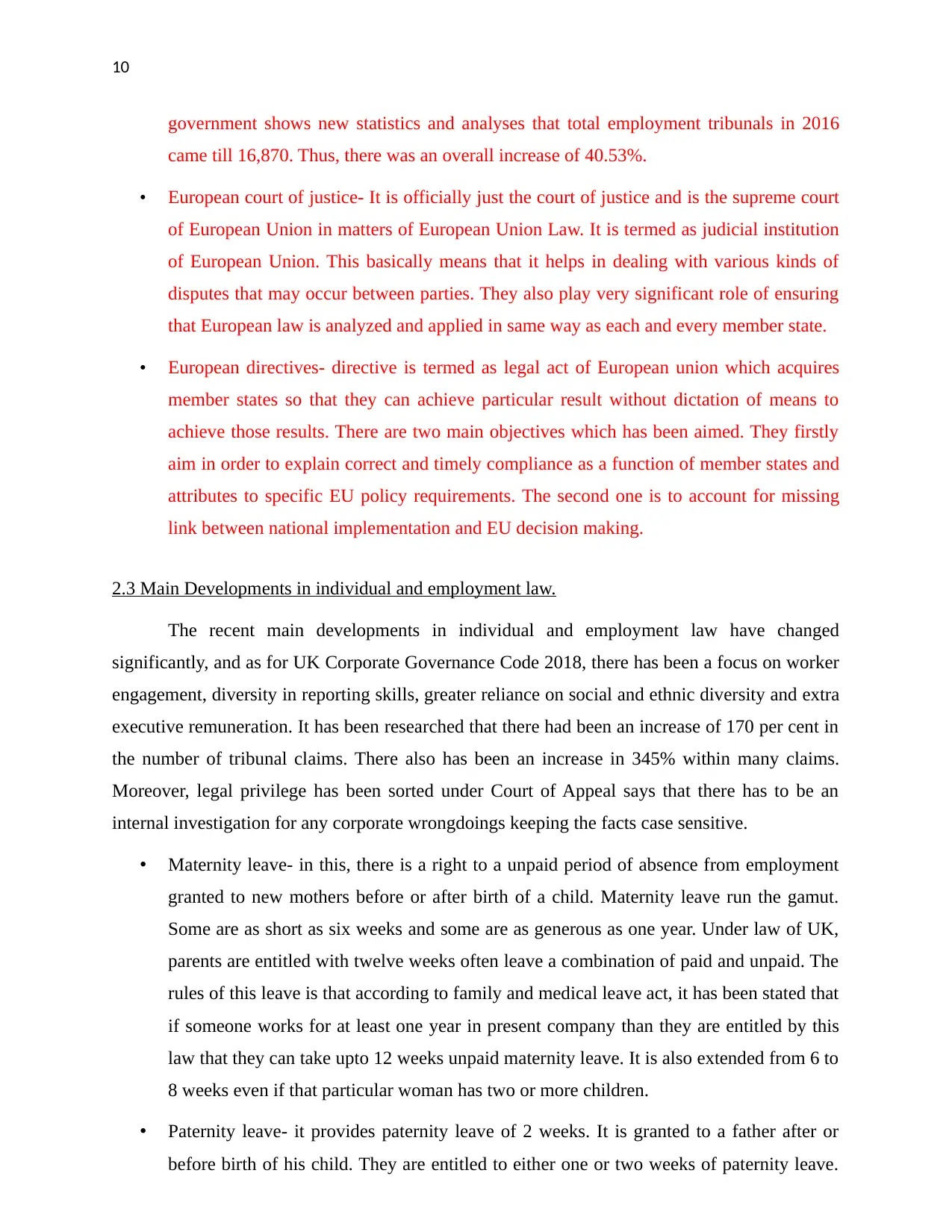
10
government shows new statistics and analyses that total employment tribunals in 2016
came till 16,870. Thus, there was an overall increase of 40.53%.
• European court of justice- It is officially just the court of justice and is the supreme court
of European Union in matters of European Union Law. It is termed as judicial institution
of European Union. This basically means that it helps in dealing with various kinds of
disputes that may occur between parties. They also play very significant role of ensuring
that European law is analyzed and applied in same way as each and every member state.
• European directives- directive is termed as legal act of European union which acquires
member states so that they can achieve particular result without dictation of means to
achieve those results. There are two main objectives which has been aimed. They firstly
aim in order to explain correct and timely compliance as a function of member states and
attributes to specific EU policy requirements. The second one is to account for missing
link between national implementation and EU decision making.
2.3 Main Developments in individual and employment law.
The recent main developments in individual and employment law have changed
significantly, and as for UK Corporate Governance Code 2018, there has been a focus on worker
engagement, diversity in reporting skills, greater reliance on social and ethnic diversity and extra
executive remuneration. It has been researched that there had been an increase of 170 per cent in
the number of tribunal claims. There also has been an increase in 345% within many claims.
Moreover, legal privilege has been sorted under Court of Appeal says that there has to be an
internal investigation for any corporate wrongdoings keeping the facts case sensitive.
• Maternity leave- in this, there is a right to a unpaid period of absence from employment
granted to new mothers before or after birth of a child. Maternity leave run the gamut.
Some are as short as six weeks and some are as generous as one year. Under law of UK,
parents are entitled with twelve weeks often leave a combination of paid and unpaid. The
rules of this leave is that according to family and medical leave act, it has been stated that
if someone works for at least one year in present company than they are entitled by this
law that they can take upto 12 weeks unpaid maternity leave. It is also extended from 6 to
8 weeks even if that particular woman has two or more children.
• Paternity leave- it provides paternity leave of 2 weeks. It is granted to a father after or
before birth of his child. They are entitled to either one or two weeks of paternity leave.
government shows new statistics and analyses that total employment tribunals in 2016
came till 16,870. Thus, there was an overall increase of 40.53%.
• European court of justice- It is officially just the court of justice and is the supreme court
of European Union in matters of European Union Law. It is termed as judicial institution
of European Union. This basically means that it helps in dealing with various kinds of
disputes that may occur between parties. They also play very significant role of ensuring
that European law is analyzed and applied in same way as each and every member state.
• European directives- directive is termed as legal act of European union which acquires
member states so that they can achieve particular result without dictation of means to
achieve those results. There are two main objectives which has been aimed. They firstly
aim in order to explain correct and timely compliance as a function of member states and
attributes to specific EU policy requirements. The second one is to account for missing
link between national implementation and EU decision making.
2.3 Main Developments in individual and employment law.
The recent main developments in individual and employment law have changed
significantly, and as for UK Corporate Governance Code 2018, there has been a focus on worker
engagement, diversity in reporting skills, greater reliance on social and ethnic diversity and extra
executive remuneration. It has been researched that there had been an increase of 170 per cent in
the number of tribunal claims. There also has been an increase in 345% within many claims.
Moreover, legal privilege has been sorted under Court of Appeal says that there has to be an
internal investigation for any corporate wrongdoings keeping the facts case sensitive.
• Maternity leave- in this, there is a right to a unpaid period of absence from employment
granted to new mothers before or after birth of a child. Maternity leave run the gamut.
Some are as short as six weeks and some are as generous as one year. Under law of UK,
parents are entitled with twelve weeks often leave a combination of paid and unpaid. The
rules of this leave is that according to family and medical leave act, it has been stated that
if someone works for at least one year in present company than they are entitled by this
law that they can take upto 12 weeks unpaid maternity leave. It is also extended from 6 to
8 weeks even if that particular woman has two or more children.
• Paternity leave- it provides paternity leave of 2 weeks. It is granted to a father after or
before birth of his child. They are entitled to either one or two weeks of paternity leave.
Paraphrase This Document
Need a fresh take? Get an instant paraphrase of this document with our AI Paraphraser
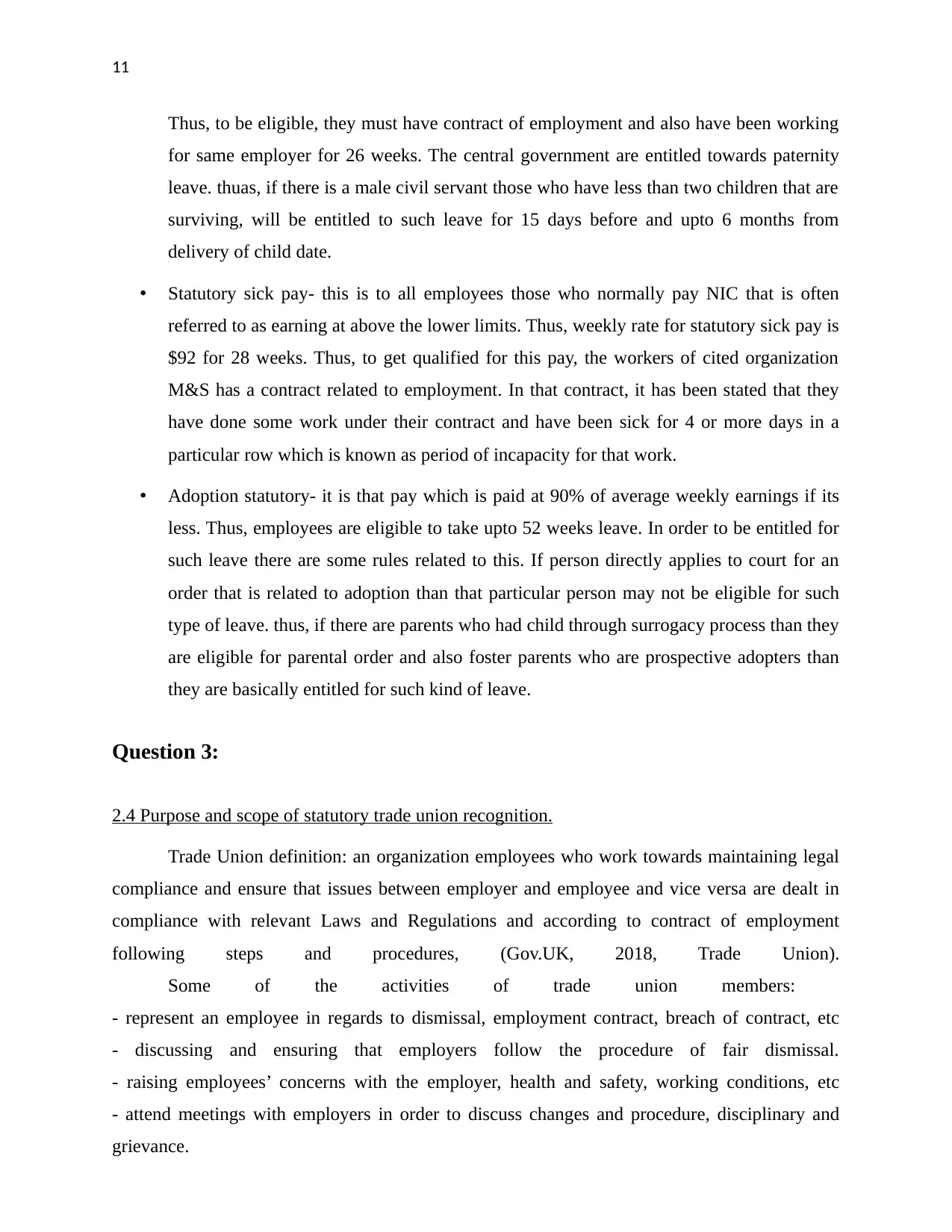
11
Thus, to be eligible, they must have contract of employment and also have been working
for same employer for 26 weeks. The central government are entitled towards paternity
leave. thuas, if there is a male civil servant those who have less than two children that are
surviving, will be entitled to such leave for 15 days before and upto 6 months from
delivery of child date.
• Statutory sick pay- this is to all employees those who normally pay NIC that is often
referred to as earning at above the lower limits. Thus, weekly rate for statutory sick pay is
$92 for 28 weeks. Thus, to get qualified for this pay, the workers of cited organization
M&S has a contract related to employment. In that contract, it has been stated that they
have done some work under their contract and have been sick for 4 or more days in a
particular row which is known as period of incapacity for that work.
• Adoption statutory- it is that pay which is paid at 90% of average weekly earnings if its
less. Thus, employees are eligible to take upto 52 weeks leave. In order to be entitled for
such leave there are some rules related to this. If person directly applies to court for an
order that is related to adoption than that particular person may not be eligible for such
type of leave. thus, if there are parents who had child through surrogacy process than they
are eligible for parental order and also foster parents who are prospective adopters than
they are basically entitled for such kind of leave.
Question 3:
2.4 Purpose and scope of statutory trade union recognition.
Trade Union definition: an organization employees who work towards maintaining legal
compliance and ensure that issues between employer and employee and vice versa are dealt in
compliance with relevant Laws and Regulations and according to contract of employment
following steps and procedures, (Gov.UK, 2018, Trade Union).
Some of the activities of trade union members:
- represent an employee in regards to dismissal, employment contract, breach of contract, etc
- discussing and ensuring that employers follow the procedure of fair dismissal.
- raising employees’ concerns with the employer, health and safety, working conditions, etc
- attend meetings with employers in order to discuss changes and procedure, disciplinary and
grievance.
Thus, to be eligible, they must have contract of employment and also have been working
for same employer for 26 weeks. The central government are entitled towards paternity
leave. thuas, if there is a male civil servant those who have less than two children that are
surviving, will be entitled to such leave for 15 days before and upto 6 months from
delivery of child date.
• Statutory sick pay- this is to all employees those who normally pay NIC that is often
referred to as earning at above the lower limits. Thus, weekly rate for statutory sick pay is
$92 for 28 weeks. Thus, to get qualified for this pay, the workers of cited organization
M&S has a contract related to employment. In that contract, it has been stated that they
have done some work under their contract and have been sick for 4 or more days in a
particular row which is known as period of incapacity for that work.
• Adoption statutory- it is that pay which is paid at 90% of average weekly earnings if its
less. Thus, employees are eligible to take upto 52 weeks leave. In order to be entitled for
such leave there are some rules related to this. If person directly applies to court for an
order that is related to adoption than that particular person may not be eligible for such
type of leave. thus, if there are parents who had child through surrogacy process than they
are eligible for parental order and also foster parents who are prospective adopters than
they are basically entitled for such kind of leave.
Question 3:
2.4 Purpose and scope of statutory trade union recognition.
Trade Union definition: an organization employees who work towards maintaining legal
compliance and ensure that issues between employer and employee and vice versa are dealt in
compliance with relevant Laws and Regulations and according to contract of employment
following steps and procedures, (Gov.UK, 2018, Trade Union).
Some of the activities of trade union members:
- represent an employee in regards to dismissal, employment contract, breach of contract, etc
- discussing and ensuring that employers follow the procedure of fair dismissal.
- raising employees’ concerns with the employer, health and safety, working conditions, etc
- attend meetings with employers in order to discuss changes and procedure, disciplinary and
grievance.
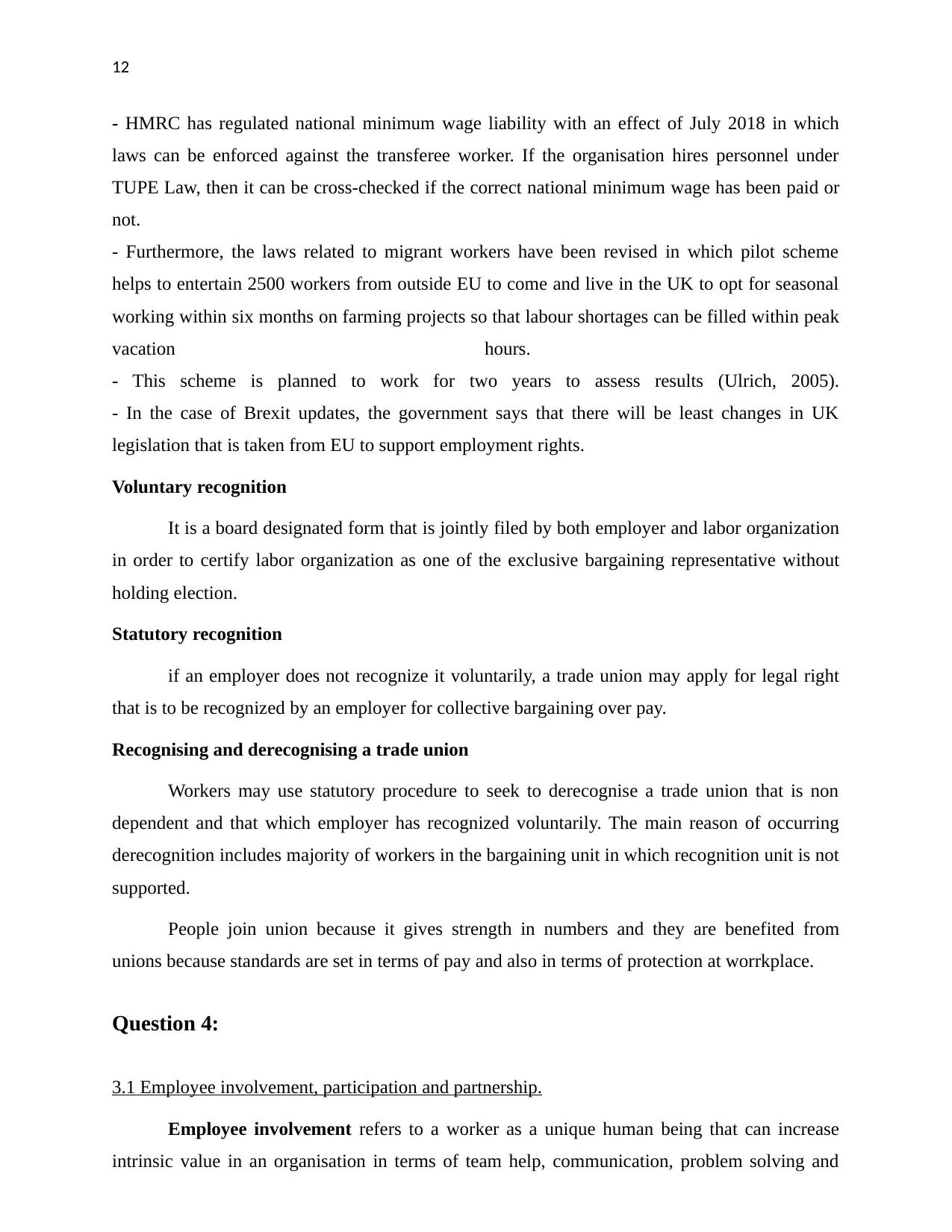
12
- HMRC has regulated national minimum wage liability with an effect of July 2018 in which
laws can be enforced against the transferee worker. If the organisation hires personnel under
TUPE Law, then it can be cross-checked if the correct national minimum wage has been paid or
not.
- Furthermore, the laws related to migrant workers have been revised in which pilot scheme
helps to entertain 2500 workers from outside EU to come and live in the UK to opt for seasonal
working within six months on farming projects so that labour shortages can be filled within peak
vacation hours.
- This scheme is planned to work for two years to assess results (Ulrich, 2005).
- In the case of Brexit updates, the government says that there will be least changes in UK
legislation that is taken from EU to support employment rights.
Voluntary recognition
It is a board designated form that is jointly filed by both employer and labor organization
in order to certify labor organization as one of the exclusive bargaining representative without
holding election.
Statutory recognition
if an employer does not recognize it voluntarily, a trade union may apply for legal right
that is to be recognized by an employer for collective bargaining over pay.
Recognising and derecognising a trade union
Workers may use statutory procedure to seek to derecognise a trade union that is non
dependent and that which employer has recognized voluntarily. The main reason of occurring
derecognition includes majority of workers in the bargaining unit in which recognition unit is not
supported.
People join union because it gives strength in numbers and they are benefited from
unions because standards are set in terms of pay and also in terms of protection at worrkplace.
Question 4:
3.1 Employee involvement, participation and partnership.
Employee involvement refers to a worker as a unique human being that can increase
intrinsic value in an organisation in terms of team help, communication, problem solving and
- HMRC has regulated national minimum wage liability with an effect of July 2018 in which
laws can be enforced against the transferee worker. If the organisation hires personnel under
TUPE Law, then it can be cross-checked if the correct national minimum wage has been paid or
not.
- Furthermore, the laws related to migrant workers have been revised in which pilot scheme
helps to entertain 2500 workers from outside EU to come and live in the UK to opt for seasonal
working within six months on farming projects so that labour shortages can be filled within peak
vacation hours.
- This scheme is planned to work for two years to assess results (Ulrich, 2005).
- In the case of Brexit updates, the government says that there will be least changes in UK
legislation that is taken from EU to support employment rights.
Voluntary recognition
It is a board designated form that is jointly filed by both employer and labor organization
in order to certify labor organization as one of the exclusive bargaining representative without
holding election.
Statutory recognition
if an employer does not recognize it voluntarily, a trade union may apply for legal right
that is to be recognized by an employer for collective bargaining over pay.
Recognising and derecognising a trade union
Workers may use statutory procedure to seek to derecognise a trade union that is non
dependent and that which employer has recognized voluntarily. The main reason of occurring
derecognition includes majority of workers in the bargaining unit in which recognition unit is not
supported.
People join union because it gives strength in numbers and they are benefited from
unions because standards are set in terms of pay and also in terms of protection at worrkplace.
Question 4:
3.1 Employee involvement, participation and partnership.
Employee involvement refers to a worker as a unique human being that can increase
intrinsic value in an organisation in terms of team help, communication, problem solving and
⊘ This is a preview!⊘
Do you want full access?
Subscribe today to unlock all pages.

Trusted by 1+ million students worldwide
1 out of 26
Related Documents
Your All-in-One AI-Powered Toolkit for Academic Success.
+13062052269
info@desklib.com
Available 24*7 on WhatsApp / Email
![[object Object]](/_next/static/media/star-bottom.7253800d.svg)
Unlock your academic potential
Copyright © 2020–2025 A2Z Services. All Rights Reserved. Developed and managed by ZUCOL.





